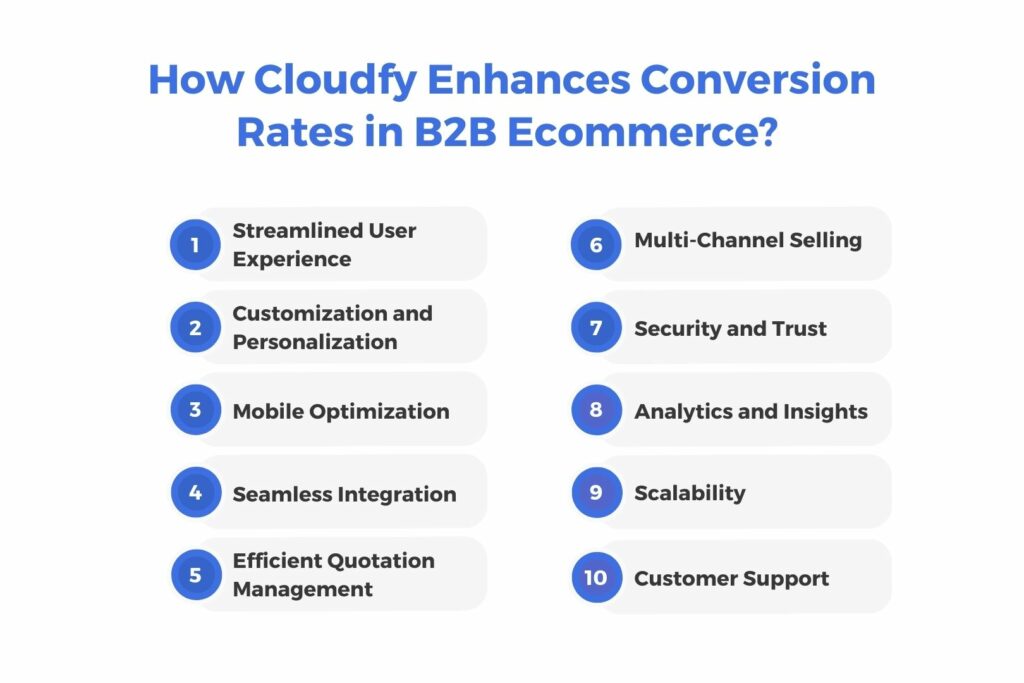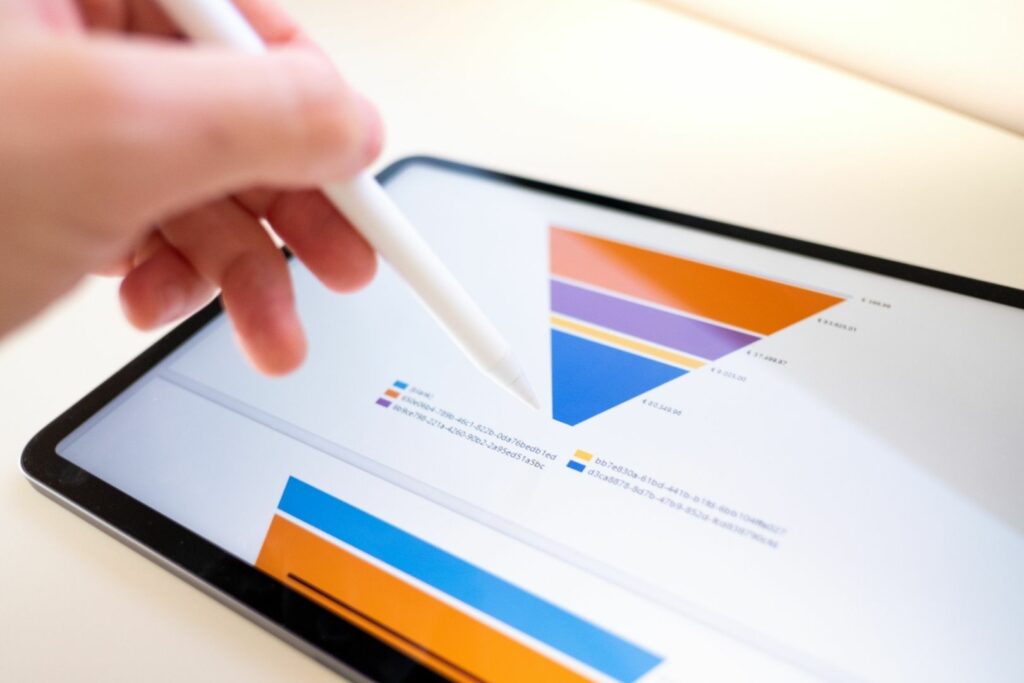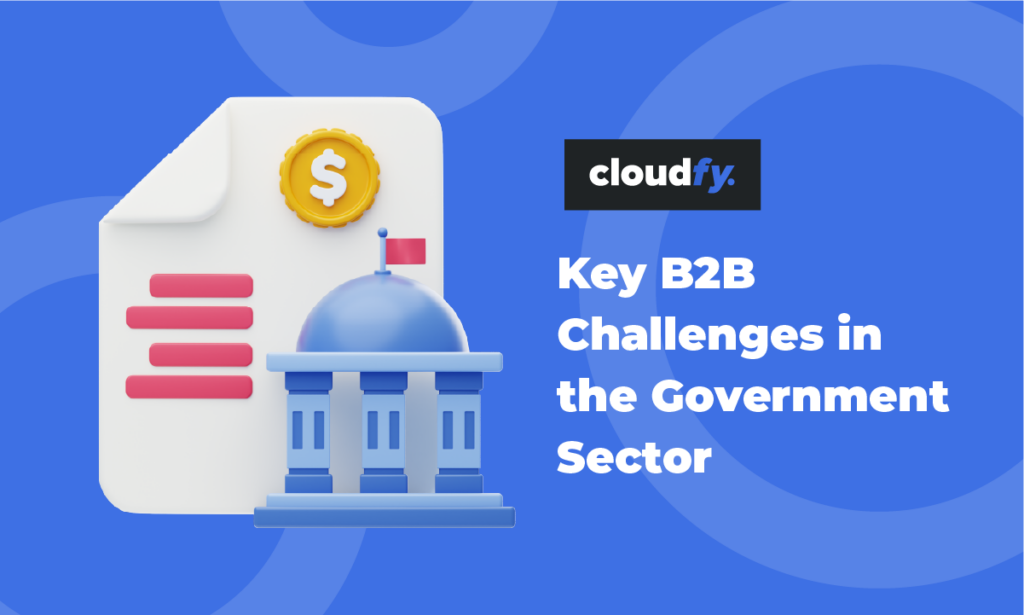In the dynamic world of ecommerce, a critical metric that can make or break your business is the conversion rate. Whether you’re selling products or services, the percentage of website visitors who complete a desired action, such as making a purchase, filling out a contact form, or subscribing to a newsletter, is a key indicator of your ecommerce business’s health. When measuring a site’s success, using conversion rates is an effective way of measuring how profitable your ecommerce business is, as well as using them to identify any areas you might need to improve.
In the world of B2B ecommerce, where complex transactions and customer relationships often come into play, achieving and maintaining healthy conversion rates is even more crucial. While conversion rates tend to differ according to different types of devices, and industries, as well as between retail and trade ecommerce businesses, the Cloudfy team has taken a look at some UK benchmark figures that can help you determine where your business stands and what conversion rates you should be aiming for. This blog explores the significance of conversion rates in B2B ecommerce and how the Cloudfy B2B ecommerce platform can be a game-changer in this regard.
Understanding Conversion Rates in Ecommerce
Before diving into how Cloudfy can enhance your conversion rates, let’s first establish the importance of this metric. Conversion rates provide insights into your website’s effectiveness in turning visitors into customers. A healthy conversion rate indicates that your ecommerce business is efficient in attracting, engaging, and ultimately converting your target audience. In B2B ecommerce, where transactions are often of higher value and complexity, achieving and maintaining healthy conversion rates is essential.
Challenges in B2B Ecommerce Conversion
Regularly collecting and analyzing data on user behavior and engagement can help refine your strategies and improve conversion rates over time. Let’s get to know the challenges and explore some strategies to overcome them:
- Complex Decision-Making: B2B ecommerce entails a more intricate decision-making process compared to B2C transactions.
- Multiple Stakeholders: B2B purchases often require the input of multiple stakeholders, leading to intricate negotiations and customized solutions.
- Extended Sales Cycles: The complexity and customization of products or services can result in longer sales cycles, potentially causing drop-offs in the conversion path.

Is mobile catching up to desktop? UK retail conversion rates by device
It is important not only to look at the overall conversion rate for your ecommerce website over time, but also to identify how conversion rates vary across certain devices (desktop vs mobile vs tablet).
According to a recent article from Smart Insights, in the UK, the average conversion rate for ‘add to basket’ for retail websites was 4.20% in Q3 2016, but when we take a deeper look, we can see how this varies across different devices with desktop topping the chart at 5.67%, followed by tablet conversion rate of 4.41% and mobile being behind at just 3.05%.
Considering the increase in mobile traffic from recent years, this suggests that conversion rates for mobile still have some catching up to do and this could be caused by a number of factors – from users browsing on mobile without being in ‘buy mode’ to websites not being optimized for mobile and thus completing an order being impossible.
But what about B2B conversion rates?
while there are less studies looking at B2B conversion rates, compared to retail metrics, as less trade businesses operate online compared to the B2C industry, in recent years there’s been a shift for B2B ecommerce to start operating more similarly to B2C one, with users’ expectations increasing. When it comes to B2B conversion rates, things also tend to be quite different compared to retail metrics and we’ve used our years of experience working in the B2B ecommerce sector to compile a list of average conversion rates for B2B we expect to see.
For brand new B2B websites that have just started trading online, ecommerce conversion rates tend to be considerably lower, especially if the main business is still operating offline. In this case, we normally expect an average conversion rate of 1-2% with desktop outperforming mobile significantly.
However, when it comes to well-established online B2B business, conversion rates can reach as high as 6-8%, with desktop conversion rates (8-9%) being also considerably higher than mobile ones (2-3%).

How Cloudfy Enhances Conversion Rates in B2B Ecommerce?
Cloudfy is a robust B2B ecommerce platform designed to address the specific needs and challenges of businesses operating in the B2B space. Here’s how Cloudfy can help your B2B ecommerce business achieve and maintain healthy conversion rates:
Cloudfy offers a user-friendly and intuitive interface, making it easier for your customers to navigate your website. Intuitive design and easy-to-use search functions enable customers to find what they need quickly, reducing friction in the conversion process.
Customization and Personalization
B2B customers often have unique needs and preferences. Cloudfy allows you to personalize the user experience by tailoring product recommendations, pricing, and content to individual customers or groups. This level of customization can significantly boost conversion rates.
Mobile Optimization
With the increasing use of mobile devices for B2B research and transactions, a mobile-optimized website is essential. Cloudfy ensures that your website is responsive and performs seamlessly on all devices, providing a consistent user experience and improving conversion rates.
Seamless Integration
Cloudfy seamlessly integrates with various enterprise resource planning (ERP) systems, ensuring that product information, inventory, and pricing are always up to date. This integration reduces data inconsistencies and helps streamline the order process, resulting in faster conversions.
Efficient Quotation Management
For B2B businesses, providing quotes is often a part of the conversion process. Cloudfy simplifies quotation management, making it easier for customers to request and receive quotes quickly. This efficiency can expedite the sales cycle and improve conversion rates.
Multi-Channel Selling
Cloudfy supports multi-channel selling, enabling you to reach your B2B customers where they are, whether it’s through your website, marketplaces, or other digital channels. This extended reach can attract more potential customers and improve conversion rates.
Security and Trust
Security is paramount in B2B transactions. Cloudfy incorporates robust security features to protect sensitive customer data, fostering trust among your customers. A secure and trustworthy environment can encourage more conversions.
Analytics and Insights
Cloudfy provides detailed analytics and reporting tools that allow you to track and analyze user behavior, sales performance, and conversion rates. These insights enable data-driven decision-making to optimize your website and improve conversion rates over time.
As your B2B ecommerce business grows, Cloudfy can scale with you. Whether you’re handling a small volume of transactions or a high volume of complex orders, Cloudfy’s scalability ensures that your platform can accommodate your business’s evolving needs.
Customer Support
Exceptional customer support is a key factor in B2B conversions. Cloudfy offers support services to assist your customers with any questions or issues they may encounter during the purchasing process, ensuring a smoother journey to conversion.
Next step – improving your conversion rates
Achieving healthy conversion rates in the world of B2B ecommerce is both a challenge and an opportunity. With the Cloudfy B2B ecommerce platform, your business can overcome the unique challenges of B2B transactions and enhance its conversion rates. By providing a user-friendly experience, customization, mobile optimization, efficient integration, and data-driven insights, Cloudfy empowers your business to thrive in the competitive B2B ecommerce landscape. Invest in the right tools and strategies, and watch your B2B ecommerce business flourish with healthy conversion rates.
Now that you know what kind of conversion rates you should expect from your website, it’s time to think about improving them further and the first type of conversion rate you should analyze and look at is the mobile one.
To find out how Cloudfy can help your B2B ecommerce business achieve higher conversion rates, contact the Cloudfy team today.
Conversion rates measure the percentage of website visitors who complete a desired action, such as making a purchase, filling out a contact form, or subscribing to a newsletter. It's a key metric for assessing the effectiveness of an ecommerce business.
Conversion rates help evaluate the profitability of an ecommerce business. They provide insights into how efficiently a website turns visitors into customers and identify areas for improvement.
B2B conversion rates tend to differ due to complex decision-making processes, the involvement of multiple stakeholders, and longer sales cycles. These factors often result in lower average conversion rates compared to B2C.
Cloudfy is a B2B ecommerce platform designed to address the unique needs and challenges of B2B businesses. It enhances conversion rates by offering a streamlined user experience, customization, mobile optimization, integration, efficient quotation management, multi-channel selling, security, analytics, scalability, and exceptional customer support.
For new B2B websites, conversion rates are usually lower, averaging around 1-2%. Well-established B2B businesses can achieve conversion rates as high as 6-8%. Desktop conversion rates often outperform mobile conversion rates.
Mobile optimization is essential because an increasing number of B2B customers use mobile devices for research and transactions. A mobile-optimized website ensures a consistent user experience, which can improve conversion rates.
Cloudfy enables B2B businesses to sell their products through various digital channels, including their website, marketplaces, and other platforms. This extended reach allows businesses to attract more potential customers and increase their conversion rates.
To improve conversion rates, businesses should focus on factors like user experience, mobile optimization, customization, integration, analytics, and providing exceptional customer support. These elements play a crucial role in enhancing conversion rates.
To discover how Cloudfy can help your B2B ecommerce business achieve higher conversion rates, contact the Cloudfy team for personalized insights and solutions.






